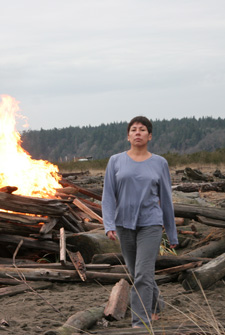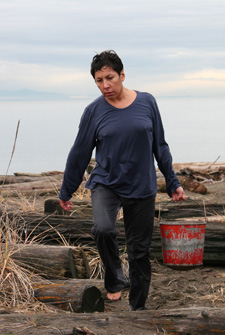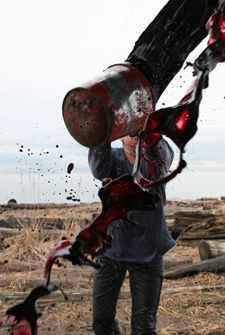


Rebecca Belmore, Fountain, 2005. Production Stills. Photos: José Ramón González.
Fifty-First International Art Exhibition
Venice Biennale 2005
Anishinabekwe artist Rebecca Belmore will be Canada's official representative at the 2005 Venice Biennale. Belmore is one of Canada's most celebrated artists. She has been at the forefront of a renaissance in native North American art for close to twenty years. Born in Upsala, Ontario and a member of the Lac Seul Band, Rebecca Belmore is currently working out of Vancouver.
Belmore's work addresses history, place, and identity. Whether it is installation, video or photograph, her art has its basis in performance, which she in turn sees as a medium shared by old traditions and modern expression—a medium both indigenous and international.
As a vehicle for polemics, Belmore’s performance art almost always features her body and her presence in the work calls forth a sense of loss for something absent. That sense of loss is for the great losses suffered by North America’s First People since European colonization.
In an early performance at the Havana Biennial (1991), Creation or Death, We Will Win, Belmore moved a pile of dirt up a long staircase, stair by stair, in a state of desperate frenzy. Dirt is lost at every stage and it is not at all certain that any of it will make it to the landing at the top of the stairs. The title of the piece reveals its intention to have the viewer experience the piece as the struggle of First Nations people to reclaim their territories and culture.
The sense of loss in Belmore’s work has been explicit and specific. In addition to lost battles and the scourge of racism, there is a loss of cosmology and nature, a remapping and reimagination of the inhabited world that imposes itself and erases culture, language and ways of apprehending.
In working with the transitions between performance, video and installation, Belmore pays special attention to the screen. The surface receiving the projection was punctured by light bulbs in her 2002 work, The Named and the Unnamed. The light bulbs solidify the screen, making it a wall as well as a window. One’s attention is always split between the palpability of the surface of the screen and the transparency of the moving image projected upon it. This cleavage she creates in the perception of the viewer, who is both invited into and rebuffed from entering the depth of the projected image, produces a disturbance many viewers will find distressing but compelling.
Rebecca Belmore’s new work, Fountain, was conceived for the Canada Pavilion at the Giardini in Venice. An image is projected through falling water onto an irregular white rock wall. The projected image is an edited DVD of a video shot cinema-style on an industrial zone beach near Vancouver, Canada. It is a cold, grey winter day, typical of the North American Pacific Northwest in January. The action is in five parts. The artist flails in the water near the shore struggling with a bucket. Next, in a calm state, she kneels and holds the vessel beneath the surface of the water. Then she rises and walks on the shore. After that, she stops and tosses the contents of the pail toward the lens, covering the screen with a sheet of blood. And, lastly, she is seen through the film of blood that fragments and distorts the image. The action has an ambiguous meaning that is associated with awakening and emerging. There is a sense of a task to be done; one of ritual and portent.
Fountain deals with elementals or essences: fire + water = blood. The time is both now, in the industrialized landscape of North America, and in another zone, a time of creation, myth and prophecy. The element of water is represented both as a body of water in the projection and literally as a wall of falling water. Water turns to blood. As befits our times, we don’t know whether this is a metaphor for creation and connectedness or an apocalyptic vision.
The Kamloops Art Gallery and the University of British Columbia's Morris and Helen Belkin Gallery which proposed Rebecca Belmore as the Biennale candidate, were the institutions selected in a nationwide competition to represent Canadian visual arts and Jann LM Bailey and Scott Watson, Directors/Curators of the two galleries respectively, are the exhibition curators. Jolene Rickard, a well-known First Nations writer has been invited by the curators to collaborate on the publication.
"Rebecca Belmore has produced a work of great power and grace," said Ms. Bailey and Mr. Watson. "Almost always based in performance, her installations have a spare, exacting sense of form and presence. Her concerns centre on history, memory and justice. The Venice Biennale is one of the most prestigious international art exhibitions of contemporary art in the world, and we are very proud to represent Canada on this world stage."